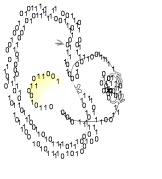Team:USTC Software/Project
From 2009.igem.org
| Home | The Team | The Project | Parts Submitted to the Registry | Modeling | Notebook |
|---|
| We hold in hands the same motivation to adventure, unfold and appreciate the secret of life via the way of virtual evolution and simulation. The seven of us major from automation to engineering, mathematics to physics, grading from freshman to PhD candidates. Though there had been hard times, we have a faith. More hopefully, we’d express our gratitude to the kind support from the School of Life Science of USTC, which makes all impossible possible.
From the one-month brainstorm we collected our first proposal – construct virtual bacteria. Yet, for some practical reasons we then shifted to a second proposal, which narrowed to molecular level simulation and later on turned out to be the prototype of our present project. | |
|
What do we desire to realize? In short, just tell us what you want your bio-device to behave, and we will return you with a list of eligible formation strategies for your design, of course, with bio-bricks. Turgidly as the idea might appear to be, this is basically an adoption of the gist of reverse engineering and evolution. By intake the custom-designated behaviors, we search, sometimes traverse, the solution space formed by nearly-inexhaustible combination of Biobricks. In order to make the simulative process applicable and practical, we employed a couple of algorithms widely used in computational sciences like Metropolis method and Dijkstra Algorithm to cut down the time cost and optimize the final result. Analysis on sensitivity and robustness has also been carried out to escort a reliable output of the final list of Biobrick combinations. | |
| USTC_Software |
Contents |
Overall project
Your abstract
Project Details
Input
The input mainly consists of three parts. A targeted curve depicting the desired time dependent behavior of the device, a user designated choice of interaction forms represented in the mathematical factors of corresponding ODEs, and an optional curve which indicates the weighs (how much you care about a specific behavior on the targeted behavior curve) exerted along the first curve. Users just need to draw those curvatures by rough sketches in a conventional GUI resembling that of a painting tablet.
System Identification
After deciding the formation of the ODE array that bears the information of the bio-system, a search in the parameter space dimensioned by all equation coefficients is set off. Generally speaking, we divide the parameter space into pieces, start parallel searching in each region, and single out ‘regional best’s by means of simulated annealing or Metropolis sampling method. The ODE array is solved by self-adaptive fourth-order Runge Kutta method.
Sensitivity Analysis
An application calls for robustness and universality to be truly applicable. As non-linear ODE array is well notorious for its instability, we realize the significance to test how sensitive the identification process relies on minor environmental perturbations existing in the coefficient matrix and initializations. …… ……
 "
"

